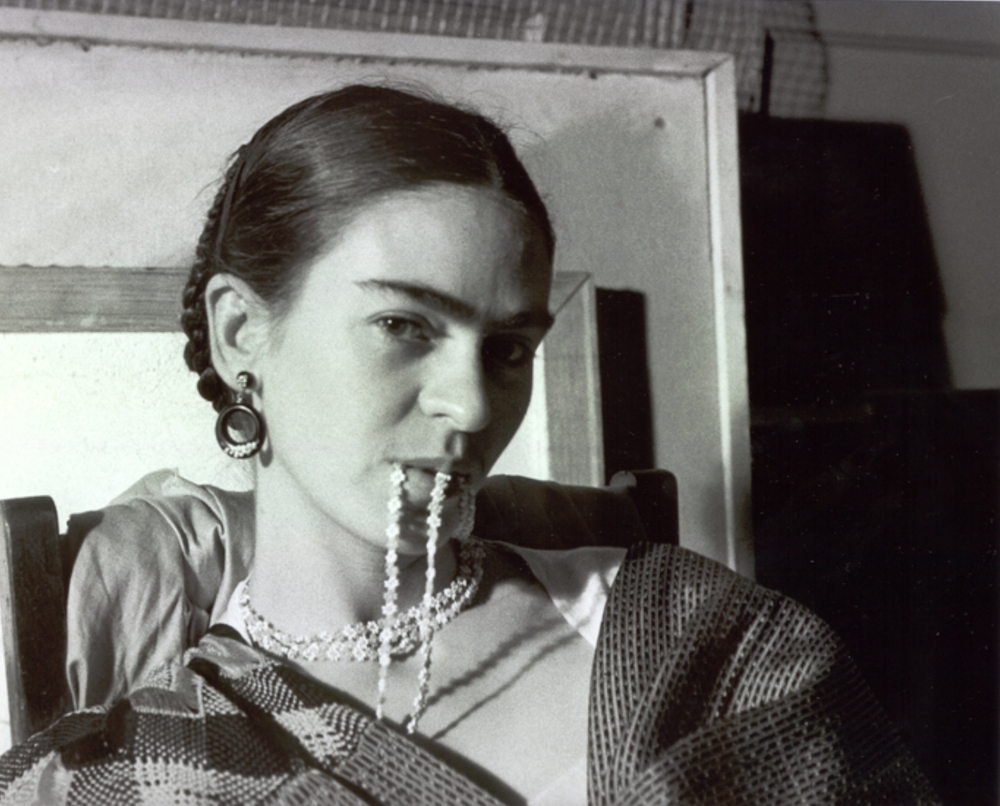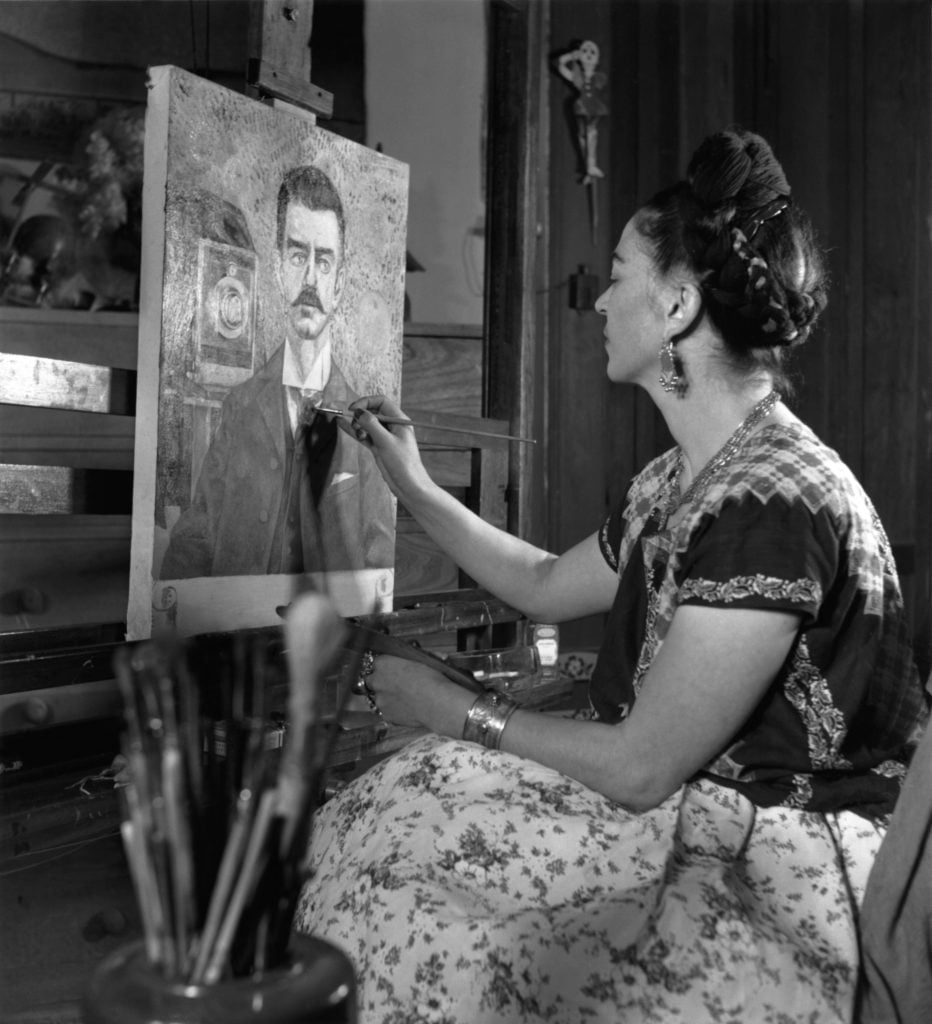Midway through the new documentary Frida comes a declaration from its subject, Mexican painter Frida Kahlo, that she would paint only her reality as she saw it. “Through no one’s eyes but my own,” she stressed. “My feelings, my moods, and my profound reactions to life.”
By the time she died at the young age of 47, Kahlo did leave behind a body of richly symbolic paintings that drew on her personal trials and turmoil. But she offered no memoir. Amid the ensuing global phenomenon known as “Fridamania”—in which the painter was variously immortalized in books and movies as a singular artist, fashion plate, and queer icon—Kahlo’s own voice has remained largely absent.
Frida, which debuted at the 2024 Sundance Film Festival, is a bid to re-inject Kahlo back into her own story. Directed by Carla Gutiérrez (RBG, Julia), the film traces the artist’s biography by stitching together the written materials she left behind, whether they be her diaries, letters, essays, or print interviews. Additional research involved delving into existing biographies, and speaking to sources such as Kahlo’s great-niece and Diego Rivera’s grandson. It was a vast undertaking, Gutiérrez told me, which took up a good part of two years.
“The team that our producer Katia Maguire put together had to collect Frida’s writings—and they’re not in one central place. The Casa Azul museum [Museo Frida Kahlo] has a lot of writings and photographs, but a lot of her letters exist in other places,” she said over a Zoom call. “But we always saw research as a way of freeing us creatively.”
The resulting first-person narrative is read by voiceover artist Fernanda Echevarría del Rivero in Kahlo’s native Spanish. It plays out alongside archival photos and footage of the artist, and a spare soundtrack by Victor Hernandez Stumpfhauser. The effect is as raw as it is intimate.
The film opens with Kahlo’s childhood in Coyoacán, where she grew up with hopes of studying medicine. A devastating bus accident cut those dreams off, confining her to bed for months and leaving her with lifelong ailments. It was while recuperating that Kahlo began to paint. Hers were personal portraits, but ones that she showed to celebrated muralist Rivera, who she first met when he was creating a fresco at her school. Kahlo called him her “toad”; he dubbed her his “dove.” They wed in 1933 and she traveled with him as he undertook commissions across the U.S.

Frida Kahlo. Photo: Lucienne Bloch, courtesy of Amazon Studios.
These biographical beats are well-trodden, but the documentary does the new thing of surfacing Kahlo’s complex interiority. She experienced profound homesickness during her time in the U.S. and disdained the New York elites that feted her husband. Gutiérrez further highlighted the difficult choice that Kahlo had to make to terminate a pregnancy while in Detroit, for fear it would endanger her already precarious health.
“Hearing that fragility and how scared she was of making that decision, that was new to me,” she said. “She was just a regular woman dealing with: ‘Is this going to change my marriage? What is my husband going to feel?’ That really made me love her more.”

Detail of Diego on my Mind (Self-portrait as Tehuana) (1943) by Frida Kahlo, on view at “Frida Kahlo and Diego Rivera – Mexican Art in the Gelman Collection” at Albergati Palace in 2016. Photo: Roberto Serra – Iguana Press/Getty Images.
Kahlo was also not one to mince words. While the American patrons rubbed her wrong, her greatest scorn was reserved for the French Surrealists, who were early in championing her work (André Breton famously characterized Kahlo’s art as “a ribbon around a bomb”). In 1939, she traveled to Paris for a solo show at the Renou et Colle Gallery, only to find she had nothing in common with the “Surrealist cacas.” She called their works “a decadent manifestation of bourgeois art” and, attempting to distance herself from their ilk, insisted: “I never painted my dreams. I painted my reality.”
“That was very surprising, how sharp her tongue was!” said Gutiérrez. “Just the many ways that she found to insult people that she did not like.”
In its boldest move, Frida also unfolds the artist’s story alongside animations of her paintings created by Sofía Inés Cázares and Renata Galindo. Kahlo’s cropped tresses fall to the ground in Self-Portrait with Cropped Hair (1940), her dresses sway in Memory, the Heart (1937)—each movement enhanced by zooms and pans. It was a fine balancing act, Gutiérrez noted, to lend dynamism to the works, while remaining respectful of Kahlo’s intentions.
“We had a lot of conversations about the different aspects of the painting and the emotional content that they carry,” she explained. “We made decisions based on that, never adding new elements to the paintings, but underlining the heart of the scene. We just went for it.”

Frida Kahlo painting her father’s portrait, Mexico, 1952. Photo: Gisele Freund/Photo Researchers History/Getty Images.
While the film includes other voices—such as those of Rivera (played by Jorge Richards) and Kahlo’s intimates including artists Lucile Blanch (Lindsay Conklin) and Lucienne Bloch (Maya Luna)—it’s del Rivero’s riveting performance that sells the painter’s inner states. Kahlo’s final acceptance of death, for one, is movingly rendered. “Even so,” she decided, “having many lives would still not be enough for me to paint everything I want.”
Del Rivero’s rounded work was achieved with Gutiérrez installing herself alongside the voiceover artist in the vocal booth to “create the feeling of being in the same space with Frida, as if she was whispering her secrets to us while she was remembering her life.” For the director, it’s these textures and insights that ultimately add to the ongoing, still-lively conversation around Kahlo’s legacy.
“The details of her life have been studied and examined; they’re well-known. I knew them all, but it was so surprising to hear how she viewed the world, how she interacted with the world, how she felt about everything,” Gutiérrez said. “It’s her perspective.”
Frida is available to stream on Amazon Prime Video from March 14.
Follow Artnet News on Facebook:
Want to stay ahead of the art world? Subscribe to our newsletter to get the breaking news, eye-opening interviews, and incisive critical takes that drive the conversation forward.
"artist" - Google News
March 15, 2024 at 06:03AM
https://ift.tt/JNqXErR
A Different Side of Frida Kahlo Emerges in a Revealing New Documentary - artnet News
"artist" - Google News
https://ift.tt/gcohJna
Bagikan Berita Ini














0 Response to "A Different Side of Frida Kahlo Emerges in a Revealing New Documentary - artnet News"
Post a Comment